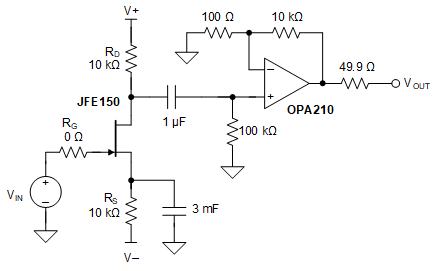SLPS732B june 2021 – april 2023 JFE150
PRODUCTION DATA
- 1 Features
- 2 Applications
- 3 Description
- 4 Revision History
- 5 Pin Configuration and Functions
- 6 Specifications
- 7 Parameter Measurement Information
- 8 Detailed Description
- 9 Application and Implementation
- 10Device and Documentation Support
- 11Mechanical, Packaging, and Orderable Information
Package Options
Mechanical Data (Package|Pins)
Thermal pad, mechanical data (Package|Pins)
Orderable Information
7.1 AC Measurement Configurations
The circuit configuration used for noise measurements is seen in Figure 7-1. The nominal IDS current is configured in the schematic by calibrating V–. After IDS is fixed, the VDS voltage is set by calibrating V+. For input-referred noise data, the gain of the circuit is calibrated from VIN to VOUT and used for the input-referred gain calculation.
 Figure 7-1 AC Measurement Reference Schematic
Figure 7-1 AC Measurement Reference Schematic